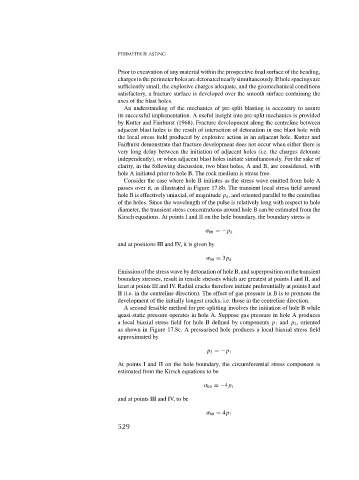Page 547 - Rock Mechanics For Underground Mining
P. 547
PERIMETER BLASTING
Prior to excavation of any material within the prospective final surface of the heading,
chargesintheperimeterholesaredetonatednearlysimultaneously.Ifholespacingsare
sufficiently small, the explosive charges adequate, and the geomechanical conditions
satisfactory, a fracture surface is developed over the smooth surface containing the
axes of the blast holes.
An understanding of the mechanics of pre-split blasting is necessary to assure
its successful implementation. A useful insight into pre-split mechanics is provided
by Kutter and Fairhurst (1968). Fracture development along the centreline between
adjacent blast holes is the result of interaction of detonation in one blast hole with
the local stress field produced by explosive action in an adjacent hole. Kutter and
Fairhurst demonstrate that fracture development does not occur when either there is
very long delay between the initiation of adjacent holes (i.e. the charges detonate
independently), or when adjacent blast holes initiate simultaneously. For the sake of
clarity, in the following discussion, two blast holes, A and B, are considered, with
hole A initiated prior to hole B. The rock medium is stress free.
Consider the case where hole B initiates as the stress wave emitted from hole A
passes over it, as illustrated in Figure 17.8b. The transient local stress field around
hole B is effectively uniaxial, of magnitude p d , and oriented parallel to the centreline
of the holes. Since the wavelength of the pulse is relatively long with respect to hole
diameter, the transient stress concentrations around hole B can be estimated from the
Kirsch equations. At points I and II on the hole boundary, the boundary stress is
=−p d
and at positions III and IV, it is given by
= 3p d
Emission of the stress wave by detonation of hole B, and superposition on the transient
boundary stresses, result in tensile stresses which are greatest at points I and II, and
least at points III and IV. Radial cracks therefore initiate preferentially at points I and
II (i.e. in the centreline direction). The effect of gas pressure in B is to promote the
development of the initially longest cracks, i.e. those in the centreline direction.
A second feasible method for pre-splitting involves the initiation of hole B while
quasi-static pressure operates in hole A. Suppose gas pressure in hole A produces
a local biaxial stress field for hole B defined by components p 1 and p 2 , oriented
as shown in Figure 17.8c. A pressurised hole produces a local biaxial stress field
approximated by
p 2 =−p 1
At points I and II on the hole boundary, the circumferential stress component is
estimated from the Kirsch equations to be
=−4p 1
and at points III and IV, to be
= 4p 1
529

